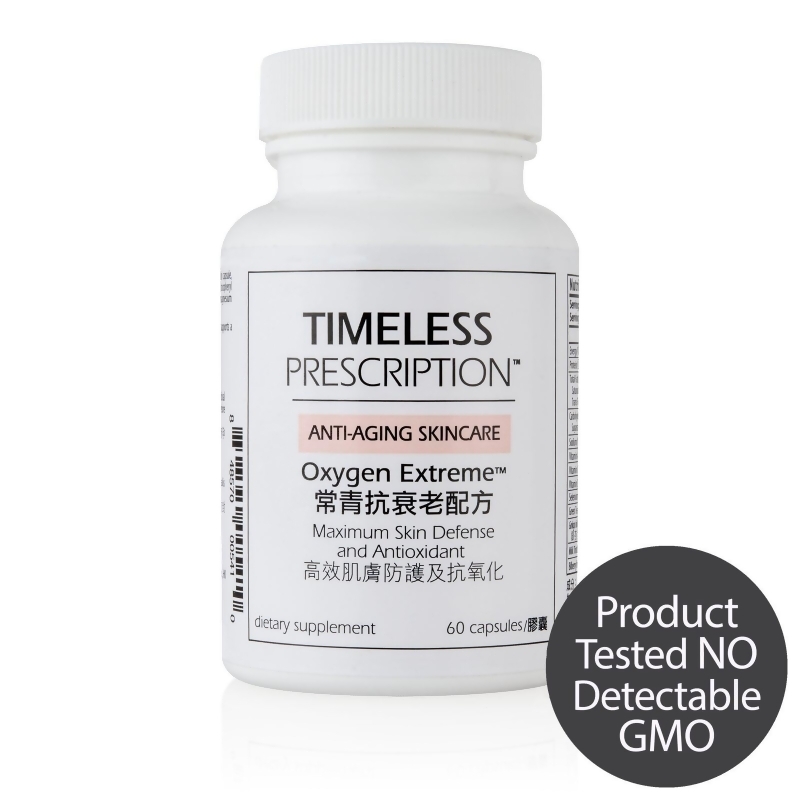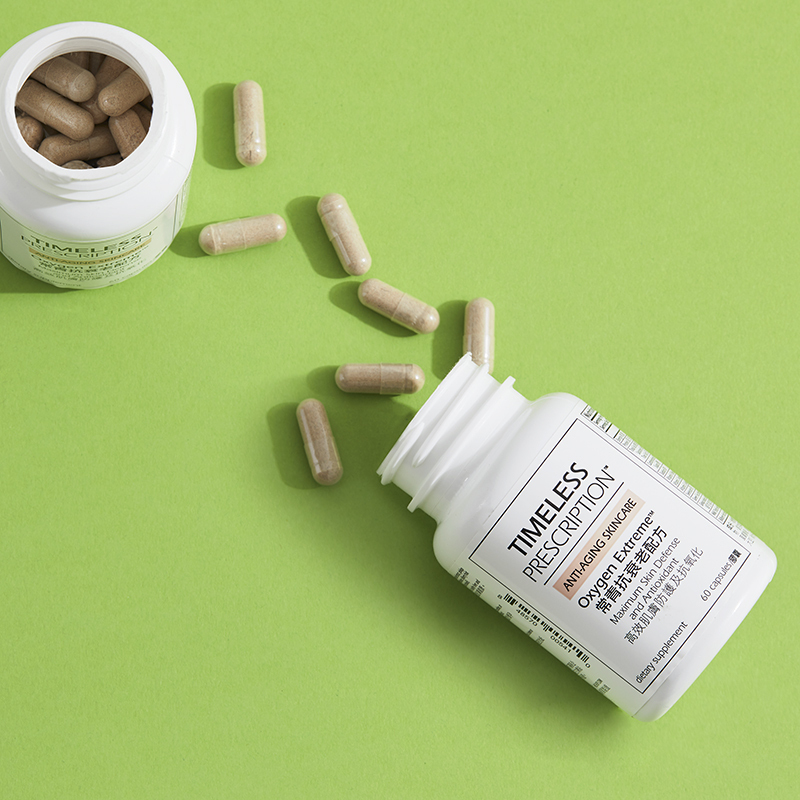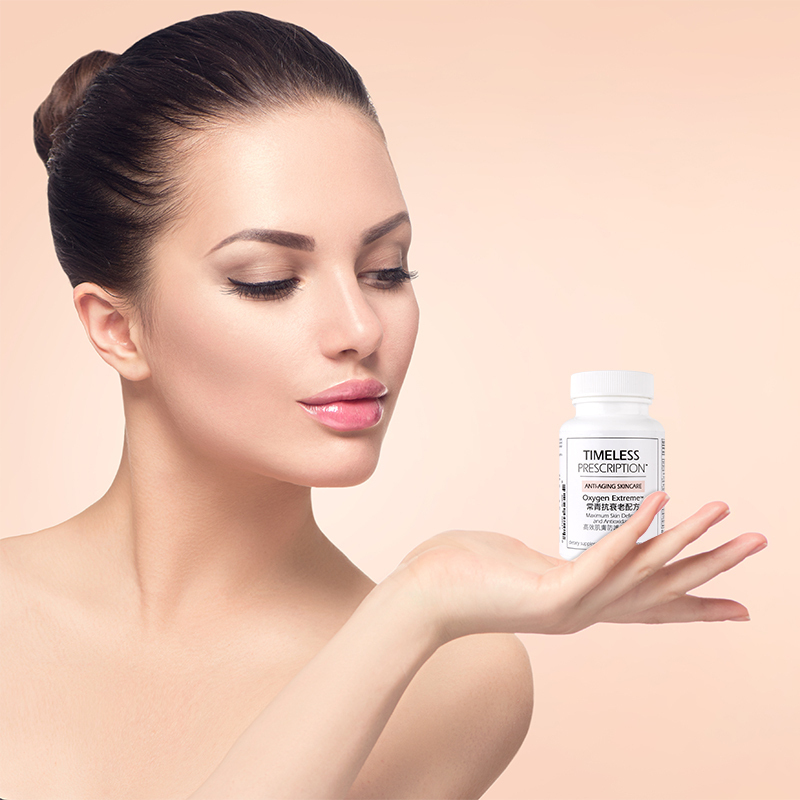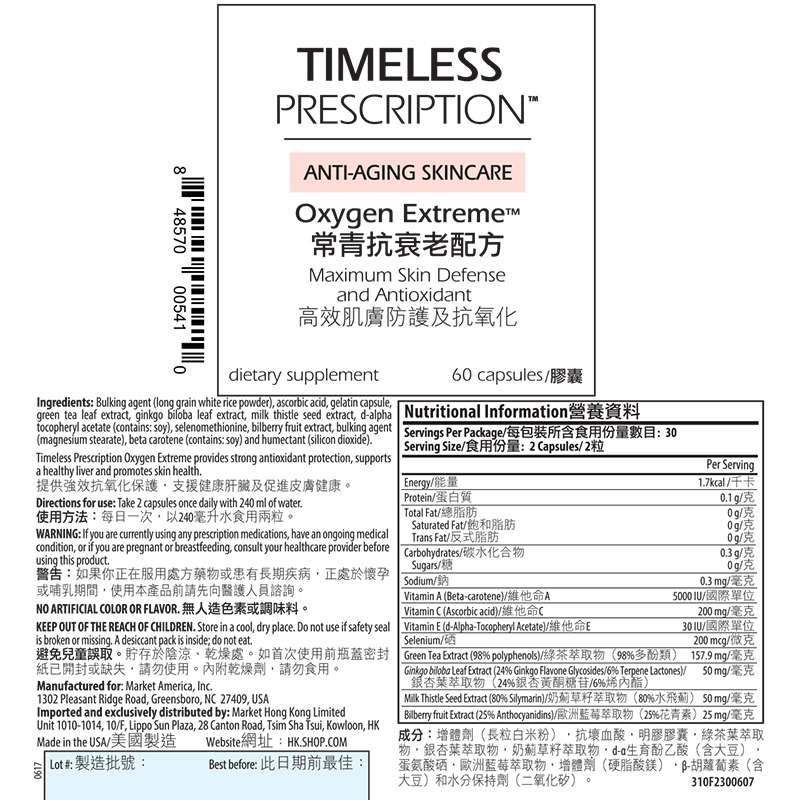Timeless Prescription™ 常青抗衰老配方
$233.00
單瓶裝(30食用份量)
Timeless Prescription常青抗衰老配方綜合了維他命、礦物質及精選草本成分,並以膠囊製成 ,幫助保護身體免受自由基傷害。此產品能對抗七種已知的自由基。 科學家相信,提升身體抗氧化物的攝取量有助延長壽命。當中的挑戰:需尋找適當的抗氧化物及適當的份量,從而有效針對體內各種的自由基
益處
- 提供強效抗氧化保護
- 支援健康免疫功能
- 幫助維持心血管健康
- 或有助穩定膽固醇*
- 促進健康的消化系統
- 支援肝臟健康
- 促進皮膚健康
- 促進眼睛及視力健康
- 促進認知健康
*此產品沒有根據《藥劑業及毒藥條例》或《中醫藥條例》註冊。為此產品作出的任何聲明亦沒有為進行該等註冊而接受評核。此產品並不供作診斷、治療或預防任何疾病之用。
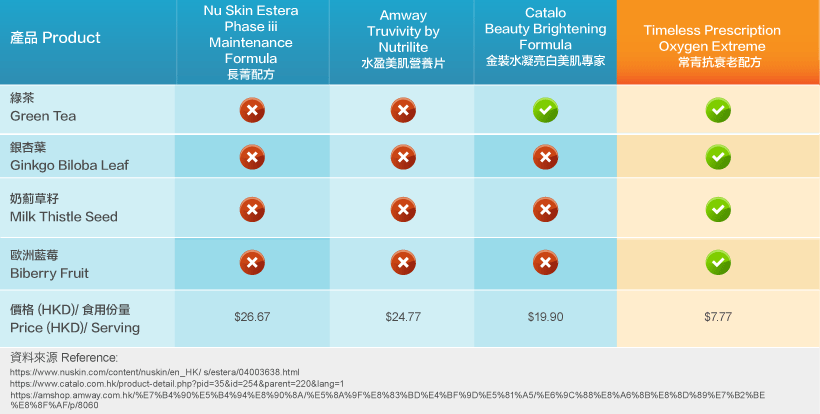
產品分類
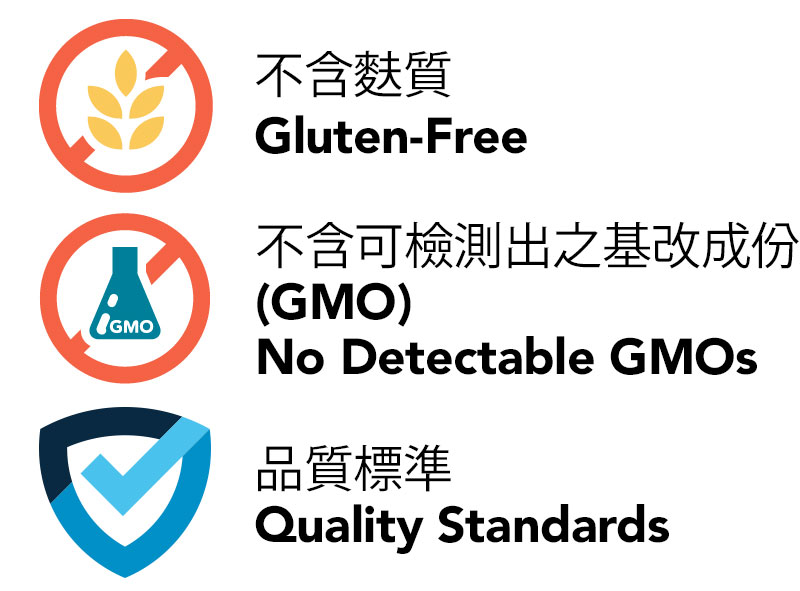
不含麩質 – 本產品不含可檢測出之麩質*
不含可檢測出之基改成份(GMO) – 本產品不含可檢測出之基因改造生物成份
品質標準 – 良好生產規範(GMP)運作與標準化成份
已檢測:重金屬丶微生物污染物丶過敏原丶效力丶純度及特性
*美國食品藥品監督管理局(FDA)將含有少於20PPM麩質的製成產品列為不含麩質
詳細資料
Timeless Prescription常青抗衰老配方綜合了維他命、礦物質及精選草本成分,並以膠囊製成 ,幫助保護身體免受自由基傷害。此產品能對抗七種已知的自由基。
科學家相信,提升身體抗氧化物的攝取量有助延長壽命。當中的挑戰:需尋找適當的抗氧化物及適當的份量,從而有效針對體內各種的自由基。
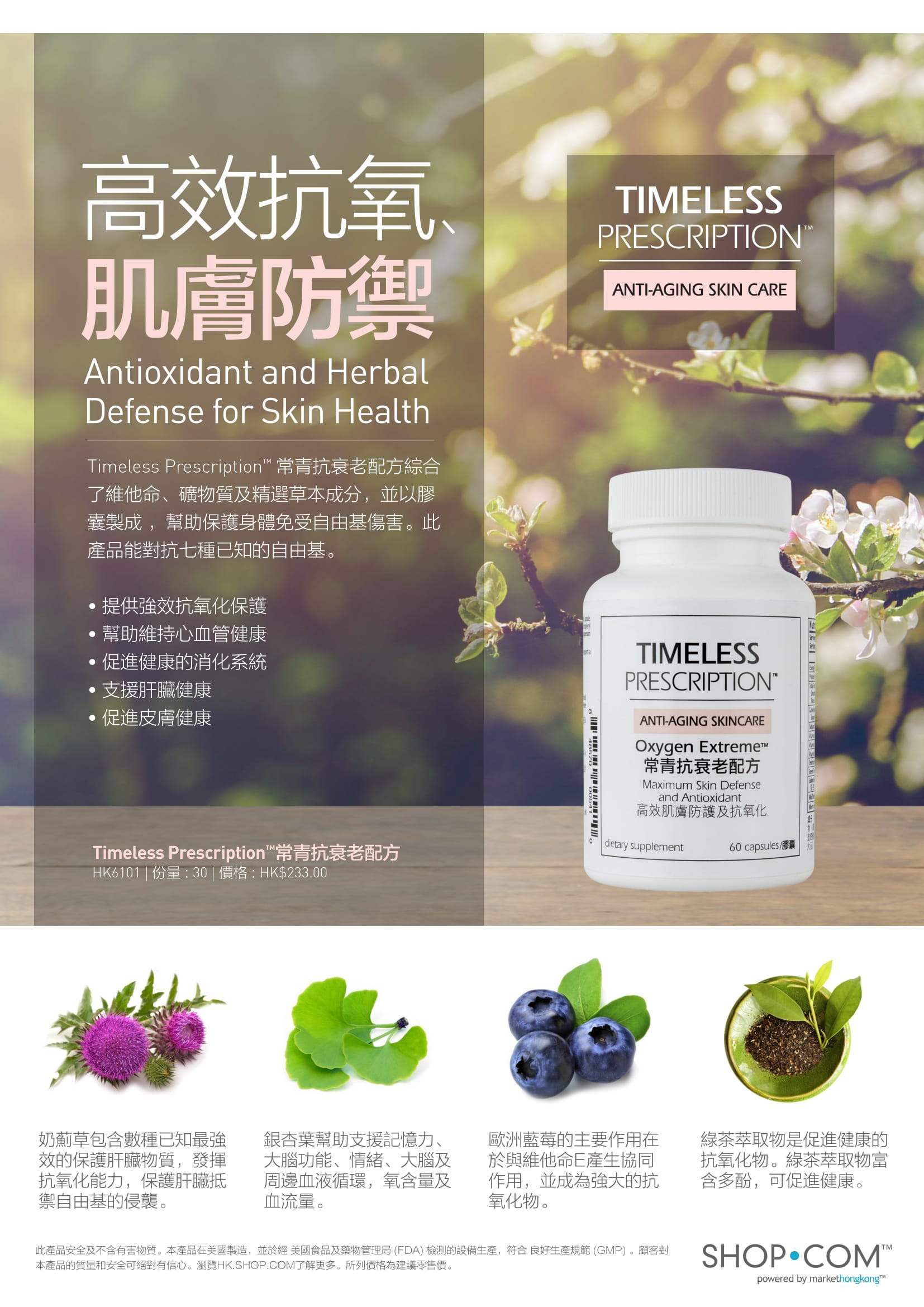
成份
維他命A(β-胡蘿蔔素)
維他命A於抗衰老微量營養素當中排列第一位,與維他命C、E及礦物質硒一起穩固地保持健康。近年研究所得,β-胡蘿蔔素對於維持身體整體健康扮演著重要的角色。β-胡蘿蔔素作為維他命A的前體,也被稱為維他命A原。當身體需要維持健康肌膚、視力及免疫系統的必需品時,β-胡蘿蔔素可被身體轉換成維他命A 。
維他命C
同時被稱為抗壞血酸。維他命C有助支援及維持皮膚內的健康骨膠原、身體正常自癒力、健康的牙齒與骨骼及免疫系統。維他命C是一個強效且常見的抗氧化物。就如切開的蘋果與空氣接觸後迅速變成咖啡色一樣,身體的細胞暴露在空氣下一樣會受到氧化的影響。氧化會導致肌膚衰老,當然也包括身體所有的器官和組織。維他命C,作為自由基的對抗者,幫助身體長久保持年輕。
維他命E
維他命E支援呼吸系統健康。同時亦促進健康免疫系統。正常老化過程中,氧氣會破壞身體的組織,維他命E可幫助身體抵禦氧化的傷害。維他命E中和自由基。自由基本身是不穩定的分子,會破壞身體健康的分子,搶奪其電子以取得自身平衡。當體內有充足的維他命E,不穩定的自由基會由維他命E中取電子,而不會傷害健康的分子,因此促進組織健康。
硒
硒是最重要的微量營養素之一,包含在長壽健康的食療中,及時常被抗衰老專家用作抗氧化物成分之一。硒和另一個強效抗氧化物 – 維他命E , 可產生協同作用,意思是指兩者可互相促進另一營養素對身體的健康效果。硒更可促進穀胱甘肽過氧化物酵素的產生,穀胱甘肽過氧化物酵素是身體主要的抗氧化物。硒是重要的微量礦物質,與維他命E密切合作,提供身體防禦自由基的抗氧化防護。硒以兩種方式保護身體抵抗自由基:硒與蛋白質結合,產生對抗氧化酵素非常重要的硒蛋白;硒支援身體產生天然的抗氧化物 – 穀胱甘肽。
歐洲藍莓
歐洲藍莓的主要作用在於與維他命E產生協同作用,並成為強大的抗氧化物。一般的情況下,它能支援微絲血管的正常阻力並促進其不滲透的本質。歐洲藍莓花青素也支援重要酵素於視網膜細胞的代謝與功能的運作。同時亦支援健康心臟。歐洲藍莓促進正常血小板活動。
綠茶萃取物
綠茶萃取物是促進健康的抗氧化物。綠茶萃取物富含多酚,可促進健康。
銀杏葉
銀杏葉幫助支援記憶力、大腦功能、情緒、大腦及周邊血液循環,氧含量及血流量。
奶薊草
用於促進肝臟健康。奶薊草包含數種已知最強效的保護肝臟物質。奶薊草可發揮抗氧化能力,保護肝臟抵禦自由基的侵襲,亦可支援肝臟新細胞的正常生成。
常見問題
甚麼是自由基?
一般情況下,份子的連結並不會分開,形成單數或未配對電子。但是,當較弱的連結斷開,便會形成自由基。自由基極度不穩定,會與其他複合物迅速作出反應,從而奪取所需的電子來回復穩定。一般來說,自由基會攻擊最接近自己的穩定分子,盜取它的電子。當受攻擊的分子失去它的電子,它就會變成自由基,產生一連串的連鎖效應。當效應一旦開始,便會有一連串反應發生,最後導致細胞受破壞。
一些自由基會在新陳代謝中正常增長。有時候,身體的免疫系統細胞會有目的地製造自由基以中和體內的病毒和細菌。然而,環境因素如污染、幅射、吸煙、除草劑亦會產生自由基。
身體多數時間可以處理自由基,但如果沒有抗氧化物,或當自由基的數量過多,就會產生氧化作用。更重要的是,由自由基而產生的氧化作用會隨年齡增長而累積。
抗氧化物如何對抗自由基?
維他命C及E被認為能保護身體,抵抗由自由基帶來的負面影響。抗氧化物透過提供自己的一顆電子以中和自由基,停止自由基的盜取行為。抗氧化營養素自身不會因貢獻出電子而變成自由基,原因是它們在任何一個形態下均能保持穩定。它們作為清除角色,幫助中和自由基。
維他命E是體內最有效的脂溶性抗氧化物之一。它是最有效、能中斷連結的抗氧化物之一。它是抵擋氧化及脂質過氧化(產生比平時更高含氧量的不穩定分子)的第一道防線。
維他命C是體內最豐富的水溶性抗氧化物之一。它的主要作用見於細胞液中。用於對抗因污染及吸煙而產生的自由基特別有效。它也能幫助維他命E重回活躍的狀態。
甚麼食物含有抗氧化物?
蔬果含有豐富的抗氧化物。問題在於處理蔬果的過程中,大多數的抗氧化物會被移除。因此,即使進食大量蔬果也不能確保你攝取足夠的抗氧化物。然而,這是一個好開始。
甚麼是最佳的抗氧化物?
對抗自由基的最佳方法是集合各種抗氧化物。沒有任何一種抗氧化物特別有效。以確保效用,各種抗氧化物需互相配合以發揮功效。你會發現使用多種抗氧化物的營養補充品,相比只攝取部分抗氧化物,會有更佳的效果。
Timeless Prescription常青抗衰老配方安全嗎?
Timeless Prescription常青抗衰老配方安全,並不含有害物質。本產品在美國製造,並於經美國食品及藥物管理局檢測的設備生產,符合良好生產規範。顧客對本產品的質量和安全可絕對有信心。
科學
- Abe, K., et al. Green Tea with a High Catechin Content Suppresses Inflammatory Cytokine Expression in the Galactosamine-injured Rat Liver. Biomedical Research. 26(5): 187-192, 2005
- Alaluf, S., et al. Dietary Carotenoids Contribute to Normal Human Skin Color and UV Photosensitivity. Journal of Nutrition. 132: 399-403, 2002.
- All-trans and 9-cis Retinoic Acids, Retinol and Beta-carotene Chemopreventive Activities during the Initial Phases of Hepatocarcinogenesis Involve Distinct Actions on Glutathione S-transferase Positive Preneoplastic Lesions Remodeling and DNA Damage. Carcinogenesis. 26(11): 1940-1946, 2005.
- Atalay, M., et al. Anti-angiogenic Property of Edible Berry in a Model of Hemangioma. Federation of European Biochemical Societies . 544: 252-257, 2003.
- Bagchi, D. Anti-angiogenic, Antioxidant, and Anti-carcinogenic Properties of a Novel Anthocyanin-Rich Berry Extract Formula. Biochemistry (Moscow). 69(1): 75-80, 2004.
- Beppu, M., et al. Water-soluble Antioxidants Inhibit Macrophage Recognition of Oxidized Erythrocytes. Biological & Pharmaceutical Bulletin. 24(5): 575-578, 2001.
- Bettuzzi, S., et al. Chemoprevention of Human Prostate Cancer by Oral Administration of Green Tea Catechins in Volunteers with High-grade Prostate Intraepithelial Neoplasia: a Preliminary Report from a One-year Proof-of-Principle Study. Cancer Research. 66(2): 1234-1240, 2006.
- Chan, D., et al. Regulation of Procollagen Synthesis and Processing during Ascorbate-induced Extracellular Matrix Accumulation In Vitro. Biochemical Journal. 269: 175-181, 1990.
- Chao, J. and Chu, C. Effects of Ginkgo biloba Extract on Cell Proliferation and Cytotoxicity in Human Hepatocellular Carcinoma Cells. World Journal of Gastroenterology. 10(1): 37-41, 2004.
- Chao, J., et al. Effects of Ginkgo biloba Extract on Cytoprotective Factors in Rats with Duodenal Ulcer. World Journal of Gastroenterology. 10(4): 560-566, 2004.
- Craig, W. Health-promoting Properties of Common Herbs. American Journal of Clinical Nutrition. 70(3): 491S-499S, 1999.
- Davidson, J., et al. Ascorbate Differentially Regulates Elastin and Collagen Biosynthesis in Vascular Smooth Muscle Cells and Skin Fibroblasts by Pretranslational Mechanisms. Journal of Biological Chemistry. 272 (1): 345-352, 1997.
- Davis-Searles, P., et al. Milk thistle and Prostate Cancer: Differential Effects of Pure Flavonolignans from Silybum Marianum on Antiproliferative End Points in Human Prostate Carcinoma Cells. Cancer Research. 65(10): 4448- 4457, 2005.
- Dhingra, S. and Bansal, M. Hypercholesterolemia and Apolipoprotein B Expression: Regulation by Selenium Status. Lipids in Health and Disease. 4: 28, 2005.
- Ellis, G., et al. Neutrophil Superoxide Anion–generating Capacity, Endothelial Function and Oxidative Stress in Chronic Heart Failure: Effects of Short- and Long-term Vitamin C Therapy. Journal of the American College of Cardiology. 36: 1474 – 1482, 2000.
- Engelhart, M. Dietary Intake of Antioxidants and Risk of Alzheimer Disease . The Journal of the American Medical Association . 287:3223-3229, 2002.
- Garcia-Casal, M., et al. Vitamin A and Beta-carotene Can Improve Nonheme Iron Absorption from Rice, Wheat and Corn By Humans. Journal of Nutrition. 128(3): 646-650, 1998.
- Gonzalez, S., et al. Dietary Lutein/Zeaxanthin Decreases Ultraviolet B-Induced Epidermal Hyperproliferation and Acute Inflammation in Hairless Mice. Journal of Investigative Dermatology. 121: 399-405, 2003.
- Gu, M., et al. Silibinin Inhibits Ultraviolet B Radiation-induced Mitogenic and Survival Signaling, and Associated Biological Responses in SKH-1 Mouse Skin. Carcinogenesis. 26(8): 1404-1413, 2005.
- Gu, M., et al. Silibinin Protects against Photocarcinogenesis via Modulation of Cell Cycle Regulators, Mitogen-Activated Protein Kinases, and Akt Signaling. Cancer Research. 64: 6349-6356, 2004.
- He, S., et al. Effects of Extract from Ginkgo biloba on Carbon Tetrachloride-induced Liver Injury in Rats. World Journal of Gastroenterology. 12(24): 3924-3928, 2006.
- Head, K. Natural Therapies for Ocular Disorders, Part Two: Cataracts and Glaucoma. Alternative Medicine Review. 6(2): 141-166, 2001.
- Heinrich, U., et al. Supplementation with {beta}-Carotene or a Similar Amount of Mixed Carotenoids Protects Humans from UV-Induced Erythema. Journal of Nutrition. 133(1): 98-101, 2003.
- Hsu, S. and Dickinson, D. A New Approach to Managing Oral Manifestations of Sjogren’s Syndrome and Skin Manifestations of Lupus. Korean Society for Biochemistry and Molecular Biology. 39(3): 229-239, 2006.
- Huang, H., et al. Effects of Vitamin C and Vitamin E on In Vivo Lipid Peroxidation: Results of a Randomized Controlled Trial. American Journal of Clinic al Nutrition. 76: 549 – 555, 2002.
- Huang, S., et al. Effect of Ginkgo biloba Extract on Livers in Aged Rats. World Journal of Gastroenterology. 11(1): 132-135, 2005.
- Ito, Y., et al. Cardiovascular Disease Mortality and Serum Carotenoid Levels: a Japanese Population-based Follow-up Study. Journal of Epidemiology. 16(4): 154-160, 2006.
- Jang, Y., et al. Anthocyanins Protect against A2E Photooxidation and Membrane Permeabilization in Retinal Pigment Epithelial Cells. Photochemistry and Photobiology. 81(3): 529-536, 2005.
- Jia, X. and Han, C. Chemoprevention of Tea on Colorectal Cancer Induced by Dimethylhydrazine in Wistar Rats. World Journal of Gastroenterology. 6(5): 699-703, 2000.
- Kidd, P. A Review of Nutrients and Botanicals in the Integrative Management of Cognitive Dysfunction. Alternative Medicine Review. 4(3): 144-161, 1999.
- Kim, H., et al. Effects of Green Tea Polyphenol on Cognitive and Acetylcholinesterase Activities. Bioscience, Biotechnology, and Biochemistry. 68(9): 1977-1979, 2004.
- Kren, V. and Walterova, D. Silybin and Silymarin—New Effects and Applications. Biomedical Papers. 149(1): 29-41, 2005.
- Kupka, R., et al. Selenium Status is Associated with Accelerated HIV Disease Progression among HIV-1-infected Pregnant Women in Tanzania. Journal of Nutrition. 134: 2556-2560, 2004.
- Lasse, M., et al. Anthocyanins Induce Cell Cycle Perturbations and Apoptosis in Different Human Cell Lines. Carcinogenesis. 25(8): 1427-1433, 2004.
- Li, L., et al. Silibinin Prevents UV-Induced HaCaT Cell Apoptosis Partly through Inhibition of Caspase-8 Pathway. Biological & Pharmaceutical Bulletin. 29(6): 1096-1101, 2006.
- Logan, A. and Wong, C. Chronic Fatigue Syndrome: Oxidative Stress and Dietary Modifications. Alternative Medicine Review. 6(5): 450-459, 2001.
- Manna, S. Silymarin Suppresses TNF-induced Activation of NF-kappa B, c-Jun N-terminal Kinase, and Apoptosis. Journal of Immunology. 163(12): 6800-6809, 1999.
- Mantena, S., et al. Orally Administered Green Tea Polyphenols Prevent Ultraviolet Radiation-Induced Skin Cancer in Mice through Activation of Cytotoxic T Cells and Inhibition of Angiogenesis in Tumors. Journal of Nutrition. 135: 2871-2877, 2005.
- Mayne, S. Antioxidant Nutrients and Chronic Disease: Use of Biomarkers of Exposure and Oxidative Stress Status in Epidemiologic Research. Journal of Nutrition. 133: 933S-940S, 2003.
- McArdle, F., et al. Effects of Oral Vitamin E and ß-carotene Supplementation on Ultraviolet Radiation–induced Oxidative Stress in Human Skin. American Journal of Clinical Nutrition. 80(5): 1270-1275, 2004.
- Nakajima, J., et al. LC/PDA/ESI-MS Profiling and Radical Scavenging Activity of Anthocyanins in Various Berries. Journal of Biomedicine and Biotechnology. 2004(5): 241-247, 2004.
- Ogasawara, M., et al. Differential Effects of Antioxidants on the In Vitro Invasion, Growth and Lung Metastasis of Murine Colon Cancer Cells. Biological & Pharmaceutical Bulletin. 30(1):200-204, 2007.
- Ohta, Y., et al. Effect of Oral Vitamin E Administration on Acute Gastric Mucosal Lesion Progression in Rats Treated with Compound 48/80, a Mast Cell Degranulator. Biological & Pharmaceutical Bulletin. 29 (4):675-683, 2006.
- Paleologos, M., et al. Cohort Study of Vitamin C Intake and Cognitive Impairment. American Journal of Epidemiology. 148(1):45-50, 1998.
- Park, Y., et al. Preventive Effect of Ginkgo biloba Extract (GBB) on the Lipopolysaccharide-induced Expressions of Inducible Nitric Oxide Synthase and Cyclooxygenase-2 via Suppression of Nuclear Factor-kappaB in RAW 264.7 Cells. Biological & Pharmaceutical Bulletin. 29(5): 985-990, 2006.
- Pence, B., et al. Effects of Dietary Selenium on UVB-Induced Skin Carcinogenesis and Epidermal Antioxidant Status. Journal of Investigative Dermatology. 102: 759-761, 1994.
- Placzek, M., et al. Ultraviolet B-Induced DNA Damage in Human Epidermis Is Modified by the Antioxidants Ascorbic Acid and D-alpha-T ocopherol. Journal of Investigative Dermatology. 124: 304-307, 2005.
- Ravindranath, M., et al. Epicatechins Purified from Green Tea (Camellia Sinensis) Differentially Suppress Growth of Gender-Dependent Human Cancer Cell Lines. Evidence Based Complementary and Alternative Medicine. 3(2): 237-247, 2006.
- Ruggiero, P., et al. Red Wine and Green Tea Reduce H pylori- or VacA-induced Gastritis in a Mouse Model. World Journal of Gastroenterology. 13(3): 349-354, 2007.
- Salonen, R., et al. Six-Year Effect of Combined Vitamin C and E Supplementation on Atherosclerotic Progression: The Antioxidant Supplementation in Atherosclerosis Prevention (ASAP) Study. Circulation. 107: 947 – 953, 2003.
- Sato, Y., et al. The Feeding of ?-Carotene Down-Regulates Serum IgE Levels and Inhibits the Type I Allergic Response in Mice. Biological & Pharmaceutical Bulletin. 27(7): 978-984, 2004.
- Shen, X., et al. Effects of Dietary Supplementation with Vitamin E and Selenium on Rat Hepatic Stellate Cell Apoptosis. World Journal of Gastroenterology. 11(32): 4957-4961, 2005.
- Simon, J., et al. Relation of Serum Ascorbic Acid to Mortality among US Adults. Journal of the American College of Nutrition. 20: 255-263, 2001.
- Singh, R., et al. Dietary feeding of Silibinin Inhibits Advance Human Prostate Carcinoma Growth in Athymic Nude Mice and Increases Plasma Insulin-like Growth Factor-binding Protein-3 Levels. Cancer Research. 62(11): 3063-3069, 2002.
- Sparrow, J., et al. A2E-epoxides Damage DNA in Retinal Pigment Epithelial Cells. Vitamin E and Other Antioxidants Inhibit A2E-epoxide Formation. Journal of Biological Chemistry. 278(20): 18207-18213, 2003.
- Trevithick-Sutton, C., et al. The Retinal Carotenoids Zeaxanthin and Lutein Scavenge Superoxide and Hydroxyl Radicals: A ChemilumInescence and ESR Study. Molecular Vision. 12: 1127-1135, 2006.
- Tyagi, A., et al. Silibinin Strongly Synergizes Human Prostate Carcinoma DU145 Cells to Doxorubicin-induced Growth Inhibition, G2-M Arrest, and Apoptosis. Clinical Cancer Research. 8(11): 3512-3119, 2002.
- Vahlquist, A., et al. Vitamin A in Human Skin: II Concentrations of Carotene, Retinol and Dehydroretinol in Various Components of Normal Skin. Journal of Investigative Dermatology. 79: 94-97, 1982.
- van der Brandt, P., et al. Toenail Selenium Levels and the Subsequent Risk of Prostate Cancer: a Prospective Cohort Study. Cancer Epidemiology Biomarkers & Prevention. 12: 866-871, 2003.
- van Rooij, J., et al. Oral Vitamins C and E as Additional Treatment in Patients with Acute Anterior Uveitis: a Randomised Double Masked Study in 145 Patients. British Journal of Ophthalmology. 83: 1277-1282, 1999.
- Varghese, L., et al. Silibinin Efficacy against Human Hepatocellular Carcinoma. Clinical Cancer Research. 11: 8441-8448, 2005.
- Wang, Z., et al. Inhibitory Effects of Black Tea, Green Tea, Decaffeinated Black Tea, and Decaffeinated Green Tea on Ultraviolet B Light-induced Skin Carcinogenesis in 7,12-Dimethylbenz[ a ]anthracene-initiated SKH-1 Mice. Cancer Research. 54(13): 3428-3435, 1994.
- Wei, W., et al. Prospective Study of Serum Selenium Concentrations and Esophageal and Gastric Cardia Cancer, Heart Disease, Stroke, and Total Death. American Journal of Clinical Nutrition. 79(1): 80-85, 2004.
- Wertz, K., et al. -Carotene Interferes with Ultraviolet Light A-Induced Gene Expression by Multiple Pathways. Journal of Investigative Dermatology. 124: 428-434, 2005.
- Xu, A., et al. Therapeutic Mechanism of Ginkgo biloba Exocarp Polysaccharides on Gastric Cancer. World Journal of Gastroenterology. 9(11): 2424-2427, 2003.
- Yoshida, M., et al. Combined Effect of Vitamin E and Insulin on Cataracts of Diabetic Rats Fed a High Cholesterol Diet. Biological & Pharmaceutical Bulletin. 27(3): 338-344, 2004.
- You, W. Gastric Dysplasia and Gastric Cancer: Helicobacter pylori, Serum Vitamin C, and Other Risk Factors. Journal of the National Cancer Institute. 92(19): 1607-1612, 2000.
- Zhang, X., et al. Effect of Tea Polyphenol on Cytokine Gene Expression in Rats with Alcoholic Liver Disease. Hepatobiliary & Pancreatic Disease International. 5(2): 268-272, 2006.
- Zhou, B., et al. Silibinin Protects Rat Cardiac Myocyte from Isoproterenol-Induced DNA Damage Independent on Regulation of Cell Cycle. Biological & Pharmaceutical Bulletin. 29(9): 1900-1905, 2006.
- Zigman, S. Effects of Green Tea Polyphenols on Lens Photooxidative Stress. Biological Bulletin. 197: 285-286, 1999.






